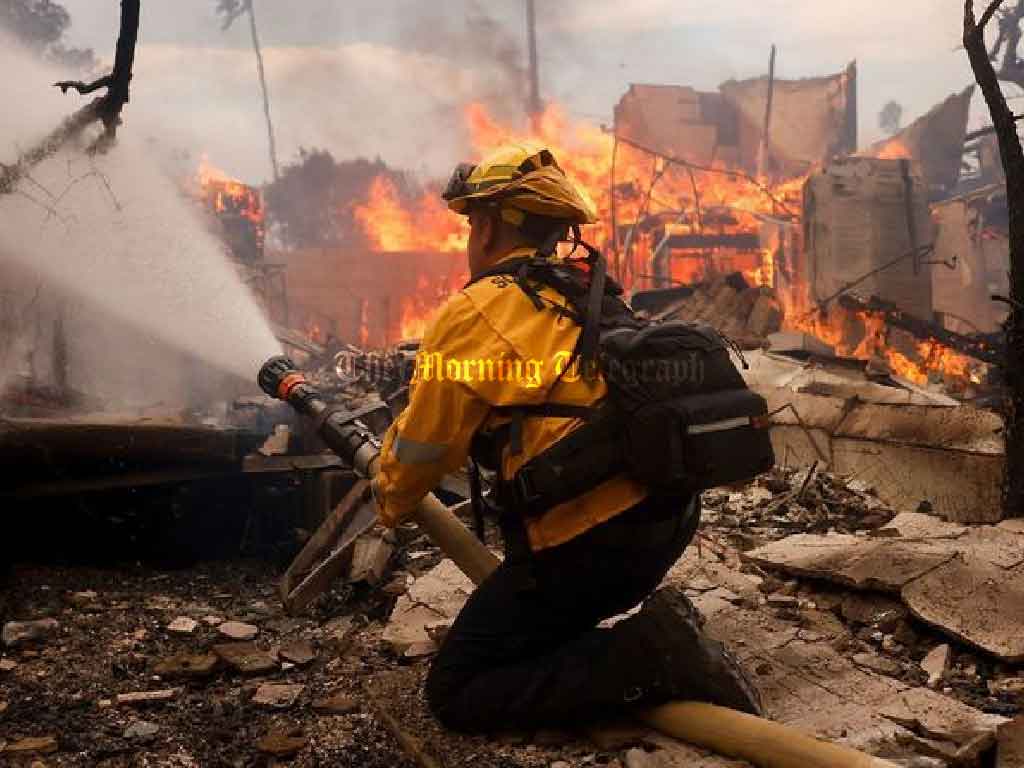
As wildfires continued to wreak havoc in Southern California, officials and experts grappled with the question of whether the devastation could have been mitigated. A CNN investigation into government reports and interviews with experts suggests that while the fires were driven by uncontrollable natural factors, some preventative measures might have reduced their impact.
Characterized as a “perfect storm” by Los Angeles officials, the fires were fueled by hurricane-force winds of up to 160 km/h, dry conditions, and a series of simultaneous blazes. These conditions grounded firefighting aircraft, preventing the early deployment of water and fire retardants.

Experts emphasized that such extreme events are becoming more common due to climate change, but human factors like inconsistent vegetation management, aging infrastructure, and inadequate planning contributed to the destruction. The fires have scorched over 142 square kilometers, destroyed thousands of structures, and claimed at least ten lives.
Water System Failures
A key issue was water availability. As flames spread, firefighters reported low hydrant pressure in multiple areas. “Got dry hydrants,” one firefighter noted in a county dispatch recording. Experts, however, argued that even a fully functioning water system could not have handled the scale of the fires.
In Pacific Palisades, where hydrants ran dry, water storage tanks were depleted after firefighters demanded four times the usual supply for 15 hours straight. Janisse Quiñones, CEO of the Los Angeles Department of Water and Power, said 20% of hydrants failed due to the unprecedented demand. Compounding the problem, a nearby reservoir undergoing repairs was empty during the fires.
In Altadena, the water crisis worsened when Southern California Edison cut power to prevent downed lines from sparking new fires. Without power, water pumps could not refill empty tanks, leaving hydrants dry.
Investigation and Accountability
California Governor Gavin Newsom has called for an independent investigation into the water supply issues, particularly the dry hydrants and empty reservoirs. “We need answers to ensure this does not happen again,” Newsom stated in a letter to Los Angeles County Public Works Director Mark Pestrella.
Los Angeles Mayor Karen Bass also promised a full review of the city’s fire response, vowing to hold individuals and departments accountable. “We will evaluate what worked, what didn’t, and take corrective action,” she said.

Budget Constraints and Fire Prevention
Los Angeles Fire Chief Kristin Crowley has repeatedly warned that budget cuts have hindered the department’s ability to prepare for large-scale disasters. A $27.6 million reduction in the fire budget last year, coupled with $11.3 million in cuts to overtime and training, has limited the department’s capacity to conduct essential brush clearance inspections.
Bass defended the cuts, stating they were made during a period of financial difficulty and did not impact the current firefighting efforts. However, Crowley criticized the decision, arguing that better funding could have helped prevent some of the damage.
Aging Homes and Building Codes
California’s building codes, introduced after the devastating 1991 Oakland fire and strengthened in 2008, have proven effective in reducing fire damage. Homes built after 2008 are 40% less likely to be destroyed than older ones. However, most homes in the areas affected by this week’s fires were built before these codes took effect. In Pacific Palisades, only 5% of structures were built after 2010, leaving the majority vulnerable.

Preparing for the Future
Experts suggest several measures to improve fire preparedness, including upgrading water systems, retrofitting older homes, and burying power lines. However, these solutions are costly and disruptive. Some researchers advocate for “managed retreat,” encouraging residents in high-risk areas to relocate to safer locations.
“We need to rethink rebuilding in fire-prone regions,” said Greg Pierce, a water-resource expert at UCLA. “The risks are escalating, and we must adapt accordingly.”
Despite the enormous challenges, local leaders and residents are already beginning to plan how to rebuild devastated neighborhoods while minimizing future risks. These efforts are crucial as climate change continues to exacerbate the severity and frequency of wildfires across the region.




